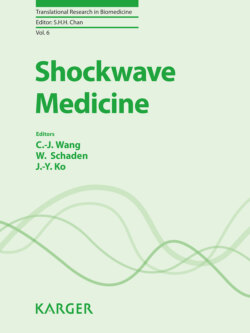Читать книгу Shockwave Medicine - Группа авторов - Страница 12
На сайте Литреса книга снята с продажи.
Introduction
ОглавлениеThe theory for extracorporeal calculi disintegration utilizing pressure waves has been explored since the 1950s, initially utilizing ultrasound waves [1–3], but its clinical viability was hampered due to the excessive tissue damage associated with this procedure. The geophysical observation of shockwave (SW) propagation by rapid-velocity raindrops, and micrometeorites by aerospace engineers, stimulated much interest and research of this phenomenon. The impact of SWs on human tissue was originally noted during World War II where underwater explosions due to depth charges caused internal tissue damage to the lungs of castaways devoid of any appreciable external evidence of trauma or violence. Professor Eberhard Häusler’s collaboration with physicians from the University of Munich and technicians from Dornier pioneered the concept and investigation of kidney stone disintegration by extracorporeal SWs [4, 5]. In 1974, a research grant titled “Application of Shockwave Lithotripsy” was awarded, and in 1980, the first patient was treated with extracorporeal shockwave lithotripsy (ESWL) [5–7]. This pioneered and revolutionized minimally invasive intervention in urology [5–7], and to date, ESWL remains the gold standard for the treatment of urolithiasis. The use of SWs was first introduced into orthopedics for the emancipation of bone cement removal in the late 1980s [7–11], but ancillary observations in 1991 of the osteoblastic responses to SW on bone [5, 8–10] would change the utility of SWs from being merely a destructive force for the disintegration and emancipation into a regenerative treatment modality. Advancements in technology have witnessed the expansion and utility of SWs in orthopedics [7, 8, 12–22], musculoskeletal medicine [23–48], vulnology [49–52], andrology [53–59], and more recently interventions in cardiology [60–66], spinal cord injury [67–70], interventions in ageing (sarcopenia), and musculoskeletal tissue resilience [71, 72]. Dose dependent stimulus from SWs are seen to engender tissue regeneration and restoration in various pathologies and more investigations are being undertaken to obtain greater elucidation about the transmission (stimulokinetics) and mechanisms of action (stimulodynamics) of medical shockwave treatment (SWT) on tissue.
